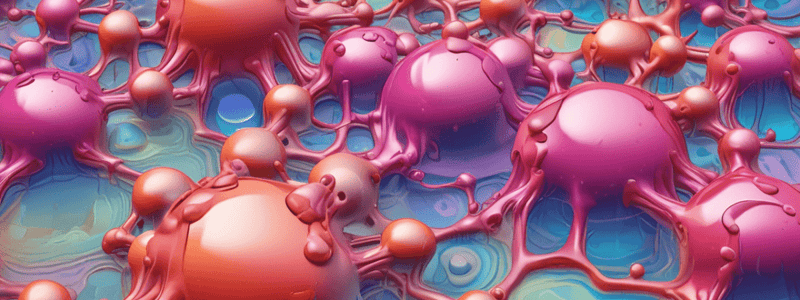Podcast
Questions and Answers
Naphthalene is not heated directly using ______ because it will vaporise quickly.
Naphthalene is not heated directly using ______ because it will vaporise quickly.
flame
It will vaporise quickly and produce flammable ______ vapours.
It will vaporise quickly and produce flammable ______ vapours.
poisonous
Naphthalene produces flammable poisonous ______.
Naphthalene produces flammable poisonous ______.
vapours
Heating naphthalene directly with flame can cause it to ______ quickly.
Heating naphthalene directly with flame can cause it to ______ quickly.
The water bath method is used for heating ______.
The water bath method is used for heating ______.
The melting point of naphthalene is lower than the boiling point of ______.
The melting point of naphthalene is lower than the boiling point of ______.
Flashcards are hidden until you start studying
Study Notes
Melting Point of Naphthalene
- Definition: The melting point is the temperature at which a solid becomes a liquid at a given pressure.
- Melting Point of Naphthalene:
- Approximately 80.2 °C (176.4 °F).
- Physical Properties:
- Naphthalene is a white crystalline solid at room temperature.
- It has a characteristic odor reminiscent of mothballs.
- Factors Influencing Melting Point:
- Purity: Impurities can lower the melting point and broaden the melting range.
- Pressure: Higher pressure can elevate the melting point.
- Applications:
- Commonly used in the production of phthalic anhydride and as a moth repellent.
- Utilized in the manufacture of dyes and as a solvent in chemical processes.
- Phase Transition:
- Naphthalene undergoes phase transitions from solid to liquid at its melting point.
- Measurement:
- Melting point determination can be done using capillary melting point apparatus or differential scanning calorimetry (DSC).
Safety Precautions
- Toxicity: Naphthalene can be harmful if inhaled or ingested; proper ventilation and protective gear are recommended.
- Flammability: Naphthalene is flammable; keep away from open flames and high temperatures.
Melting Point of Naphthalene
- Melting point marks the transition from solid to liquid at specific pressure conditions.
- Naphthalene's melting point is about 80.2 °C (176.4 °F).
- At room temperature, naphthalene appears as a white crystalline solid with a distinctive odor akin to mothballs.
Factors Influencing Melting Point
- Purity greatly affects melting point; impurities can decrease the melting point and cause a wider melting range.
- Increased pressure can result in a higher melting point for naphthalene.
Applications
- Naphthalene is primarily utilized in the synthesis of phthalic anhydride.
- It serves as a moth repellent and is essential in dye manufacturing.
- Acts as a solvent in various chemical processes.
Phase Transition
- The phase change from solid to liquid occurs at the melting point of naphthalene.
Measurement Techniques
- Melting point can be accurately determined using capillary melting point apparatus or differential scanning calorimetry (DSC).
Safety Precautions
- Naphthalene is toxic, posing risks if inhaled or ingested; proper ventilation is crucial and protective gear is advised.
- It is flammable; naphthalene should be kept away from flames and high heat sources.
Melting Point of Naphthalene
- Melting point: Approximately 80.2 °C (176.4 °F), the temperature at which naphthalene transitions from solid to liquid.
- Physical form: Naphthalene appears as a white crystalline solid at room temperature, characterized by a mothball-like odor.
Factors Influencing Melting Point
- Purity: The presence of impurities can reduce the melting point and increase the melting range of naphthalene.
- Pressure: An increase in pressure typically raises the melting point of naphthalene.
Applications
- Industrial use: Naphthalene is widely used in producing phthalic anhydride, which is important for manufacturing plastics and dyes.
- Moth repellent: Commonly found as a moth repellent to protect clothing and fabrics.
- Solvent: Utilized in chemical processes due to its solubility properties.
Phase Transition
- Naphthalene experiences a phase transition from solid to liquid at its melting point, indicating changes in molecular structure and arrangement.
Measurement Techniques
- Capillary method: A capillary melting point apparatus can accurately determine the melting point of naphthalene.
- DSC: Differential scanning calorimetry (DSC) is another technique used for measuring thermal properties, including melting point.
Safety Precautions
- Toxicity: Naphthalene poses health risks if inhaled or ingested; adequate ventilation and the use of protective gear are essential.
- Flammability: Highly flammable; it's important to keep naphthalene away from open flames and high temperatures to prevent fires and hazardous vapor formation. Direct heating with a flame is prohibited due to rapid vaporization and potential for producing poisonous vapors.
Melting Point of Naphthalene
- Melting point refers to the temperature at which a solid transitions to a liquid under specific pressure conditions.
- Naphthalene has a melting point of approximately 80.2 °C (176.4 °F).
- At room temperature, naphthalene appears as a white crystalline solid and has a distinctive mothball-like odor.
- Impurities in naphthalene can reduce its melting point and broaden the range over which melting occurs.
- Increased pressure can elevate the melting point of naphthalene.
- Naphthalene is widely used to produce phthalic anhydride and serves as a moth repellent.
- It is also utilized in dye manufacturing and as a solvent in various chemical processes.
- Naphthalene transitions from solid to liquid precisely at its melting point.
- Melting point can be measured with capillary melting point apparatus or differential scanning calorimetry (DSC).
Safety Precautions
- Naphthalene is toxic and poses potential health risks if inhaled or ingested; adequate ventilation and the use of protective equipment are essential.
- It is flammable; maintain a safe distance from open flames and avoid high temperatures.
- Directly heating naphthalene with a flame is dangerous due to rapid vaporization and emission of flammable, toxic vapors.
- It is recommended to heat naphthalene using a water bath, as its melting point is below the boiling point of water.
Studying That Suits You
Use AI to generate personalized quizzes and flashcards to suit your learning preferences.



